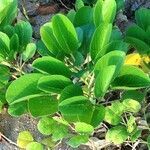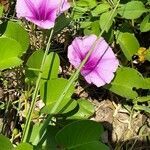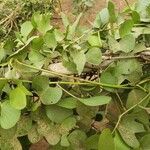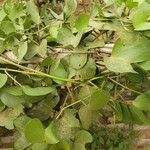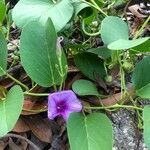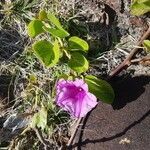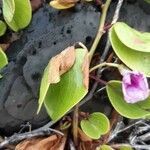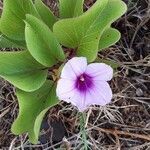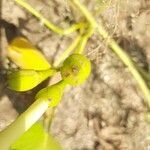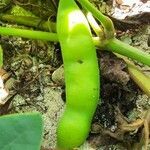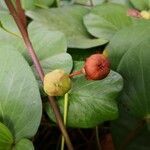Vines; stems long-trailing and rooting at the nodes, perennial with a thickened taproot, glabrous. Leaves often secund, ovate, obovate, elliptic, orbicular, or transverse-elliptic to reniform, 3-10 cm long, basally truncate, attenuate or cor-date, apically mostly emarginate, rarely truncate, mucronulate, fleshy, glabrous. Flowers in mostly 1-flowered, occasionally cymose inflorescences, glabrous; sepals subequal, the outer sepals ovate to broadly elliptic, the inner sepals mostly or-bicular, 5-11 mm long, obtuse and mucronulate, glabrous, subcoriaceous; corolla limb pink to lavender-purple, throat darker purplish within, 3-5 cm long. Fruits capsular, ovoid to depressed-globular, 12-17 mm in diameter, glabrous; seeds black, densely brownish-tomentose.
Deeply tap-rooted glabrous perennial. Stems prostrate, trailing, to c. 10-(20) m long, rooting at nodes, terete. Petiole to c. 11 cm long, usually erect. Lamina 4-12-(17) × 3.5-12-(15) cm, broad-oblong to suborbicular, entire, thick; base cuneate to truncate; apex emarginate or shallowly 2-lobed. Infl. 1-several-flowered; peduncles 3-c. 15 cm long; pedicels 1-3 cm long. Sepals 8-12 mm long, unequal, ovate, obtuse. Corolla 3-5 × (4)-4.5-5-(5.5) cm, funnelform, pink with an irregular rose band inside around the base of the limb. Stamens included. Capsule c. 2 cm long, globose-ovoid. Seeds 2-4, brownish tomentose.
Glab. prostrate or trailing branched woody plant with stems up to ± 10 m. long, rooting at intervals. Lvs on petioles up to ± 10 cm. long; lamina (2)-5-(10) cm. diam., broad-oblong to suborbicular, thick, fleshy, emarginate to bluntly 2-lobed. Peduncles 1-3-fld. Sepals ovate, obtuse; corolla ± 4 cm. diam., light purple to pink. Capsule ± 15 mm. diam., ovoid-globose, 2-loculed. Seeds 2-4, villous.
Trailing perennial to 30 m with milky sap. Leaves leathery, suborbicular and emarginate or bilobed. Flowers pink to purple, sepals glabrous, obtuse-mucronate.

